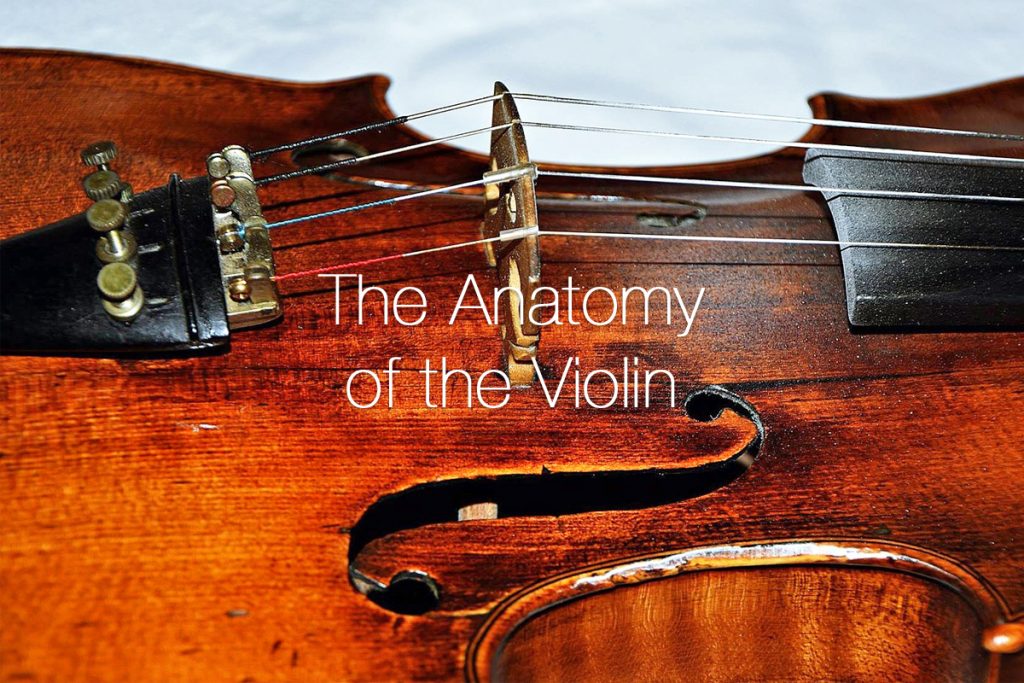
The violin is the smallest and highest-pitched member of the violin family. Also known as the fiddle, this beautiful instrument is usually made from wood with a hollow body, although electric versions are available. Each part of the violin plays an important role in how the instrument works:
Scroll: The scroll is a decoratively carved piece of wood at the violin’s top. It is typically carved in the shape of a volute (a spiral) which dates back to the Baroque period, although some luthiers will carve the scroll into different shapes or adorn it with decoration.
Peg Box: Below the scroll is the peg box; it is a hollowed-out compartment which houses the tuning pegs.
Pegs: There are four tuning pegs on a violin. The strings are wound around the pegs, allowing the player to tune the violin by either tightening or loosening the strings by turning the pegs.
Nut: The nut is a piece of wood below the peg box. It sits where the fingerboard meets the peg box and has grooves in which the rest of the string keeps them aligned and rises at an exact height above the fingerboard.
Neck: The neck of the violin extends from the body and holds the fingerboard and the strings.
Fingerboard: The fingerboard is attached to the neck of the violin. The fingerboard is curved to allow the player to bow each string. Unlike the guitar, the violin fingerboard does not have any frets.
Upper Bout: The upper bouts are the two curves in the upper half of the violin. The violin’s distinctive hourglass shape allows for maximum sound production.
Strings: The violin hosts four strings; the pitches of the open strings are G, D, A, and E. Traditionally, violin strings were made of catgut (dried-out sheep or goat intestines), but they are now made of metallic materials such as titanium and aluminium.
Waist: The waist, also known as the c-bouts, are the cutouts in the middle of the violin’s body. The waist makes room for the bow and is the main feature of the violin’s distinctive shape.
F-Holes: The f-holes are named for their distinctive “f” shape and are located on either side of the bridge. The f-holes allow air to move in and out of the violin to aid sound production.
Bridge: The bridge is a decoratively carved piece of wood located between the f-holes and held in place by the tension of the strings. The bridge holds the strings above the violin to allow the strings to vibrate freely and transfer the vibrations to the instrument’s top and the sound post inside.
Lower Bout: The lower bouts are the two curves at the bottom of the violin below the waist.
Fine Tuners: The fine tuners are located on the violin’s tailpiece and are used to make smaller adjustments to the pitch of the strings. It is common to only find one fine tuner on a violin located on the E string. However, some violins do have them on all strings.
Tailpiece: The tailpiece is located in the lower part of the violin. It is used to anchor the strings to the lower end of the violin. The tailpiece is held in place using a tailgut.
Chinrest: The chinrest is used by the player to position the violin between the chin and the shoulder comfortably.
End Button: The end button is right at the violin’s bottom. It is used to hold the tail gut and tailpiece in place.
Bow: The violin is usually played using a bow. The bow is typically made from wood with a ribbon of horsehair held between the tip and the frog. When the bow is drawn across the strings, the friction causes the strings to vibrate, producing sound.

